摘要
This application note discusses how to connect the DS31256 HDLC Controller to the DS2155, DS21Q55, DS21Q50, and DS26528 in T1/E1, 2MHz, 4MHz, 8MHz clock mode. The hardware connection and software configuration are given.
Overview
Maxim offers a complete line of communications products. The devices provide highly integrated solutions for applications including T-carrier and E-carrier, broadband, and so on.
The DS31256 has 256 independent directional HDLC channels and supports up to 64 T1 or E1 data streams simultaneously. It supports 16 channelized or unchannelized ports and each channelized port can handle one, two or four T1 or E1 lines. There are also three fast ports on the that can each handle up to 52Mbps in both transmit and receive directions, suitable for VDSL, HSSI, or clear-channel T3 applications. All 16 ports can operate from 0 to 10Mbps when configured in unchannelized mode, and gapped clocking is supported on all ports.
The DS2155 and DS21Q55 enable the user to select - under software control - T1, E1, or J1 protocol. This simplifies the design of low-cost multiprotocol interfaces. A high-performance LIU, flexible architecture, and rich feature set make the DS2155 an excellent solution to all standard T1, E1, and J1 applications including routers, switches, muxes, ADMs, and CSU/DSUs.
The DS21Q50 contains all functions necessary for connecting to four E1 lines. It is ideally suited for E1 data pipe applications where high performance must be achieved at a low price. In addition to the four transceivers, an extra jitter attenuator resource is available to clean up transmit or backplane clocks. A clock synthesizer is available for generating backplane clocks from 2.048MHz to 16.384MHz and a single clock synthesizer can be shared between multiple DS21Q50s to facilitate smooth clock-source switching.
Connection with DS2155
Connection in T1 Mode
Hardware Configuration
Figure 1 shows the connection between DS2155 and DS31256 in T1 mode. The receive elastic store is bypassed in the framer because the transmit clock is sourced from the RCLK pin. The transmit synchronization signal is sourced from the RSYNC pin.
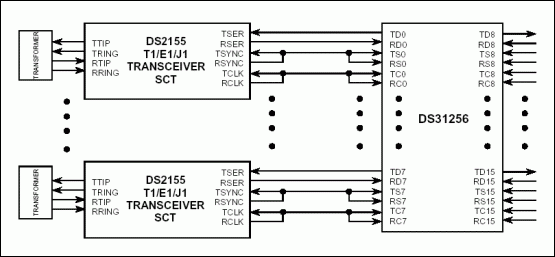
Figure 1. DS2155 connected to DS31256 in T1 and E1 mode.
Software Configuration
Tables 1 and 2 show some of the critical register settings necessary to initialize the DS31256 and DS2155 for the operation described above. Note that they might not represent the complete register listing required for a customer application. The reader is encouraged to refer to device data sheets for further information regarding the flexibility of the DS31256 and DS2155.
| SETTING | LOCATION | FUNCTION |
| RSSO = 0 RSS1 = 0 RUEN = 0 |
RP[n]CR | Set Rx port T1 mode; Set Rx port channelized mode enable |
| TSSO = 0 TSS1 = 0 TUEN = 0 |
TP[n]CR | Set Rx port T1 mode; Set Rx port channelized mode enable |
| SETTING | LOCATION | FUNCTION |
| T1/E1 = 0 | MSTRREG.1 | Select the T1 operating mod |
| TSIO = 0 | IOCR1.1 | TSYNC is an output |
| RSIO = 0 | IOCR1.4 | RSYNC is an output |
| TCLKINV = 0 | IOCR2.6 | TCLK no inversion |
| RCLKINV = 0 | IUOCR2.7 | RCLK no inversion |
| RB8ZS = 1 | T1RCR2.5 | Receive B8ZS enabled |
| RFM = 1 | T1RCR2.6 | Receive ESF framing mode |
| TB8ZS = 1 | T1TCR2.7 | Transmit B8ZS enabled |
| TFM = 1 | T1CCR1.2 | Transmit ESF framing mode |
| RESE = 0 | ESCR.0 | Receieve elastic store is bypassed |
| TPD = 1 | LIC1.0 | Normal transmitter operation |
| TUA = 1 | LIC2.4 | Transmit data normally |
| ETS = 0 | LIC2.7 | T1 mode selected |
Connection in E1 Mode
Hardware Configuration
The connection between DS2155 and DS31256 in E1 mode is similar to T1 mode. The PCM31 framing mode is selected. The Receive elastic store is bypassed. The Transmit Clock is sourced from the RCLK pin. The Transmit Synchronization signal is sourced from the RSYNC pin.
Software Configuration
Tables 3 and 4 show some of the critical register settings necessary to initialize the DS31256 and DS2155 for operation as described above. Note that they might not represent the complete register listing required for a customer application. The reader is encouraged to refer to the device data sheet for further information regarding the flexibility of the DS31256 and DS2155.
| SETTING | LOCATION | FUNCTION |
| RSSO = 0 RSS1 = 1 RUEN = 0 |
RP[n]CR | Set Rx port E1 mode; Set Rx port channelized mode enable |
| TSSO = 0 TSS1 = 1 TUEN = 0 |
TP[n]CR | Set Tx port E1 mode; Set Tx port channelized mode enable |
| SETTING | LOCATION | FUNCTION |
| T1/E1 = 1 | MSTRREG.1 | Select the E1 operating mode |
| TSIO = 0 | IOCR1.1 | TSYNC is an output |
| RSIO = 0 | IOCR1.4 | RSYNC is an output |
| TCLKINV = 0 | IOCR2.6 | TCLK no inversion |
| RCLKINV = 0 | IUOCR2.7 | RCLK no inversion |
| SYNCE = 0 | E1RCR1.1 | Receive auto resync enabled |
| RHDB3 = 1 | E1RCR1.5 | Receive HDB3 enabled |
| RSIGM = 1 | E1RCR1.6 | Receive CCS signaling mode |
| RCRC4 = 1 | E1RCR1.3 | Receive CRC4 enabled |
| TCRC4 = 1 | E1TCR1.0 | Transmit CRC4 enabled |
| THDB3 = 1 | E1TCR1.2 | Transmit HDB3 enabled |
| RESE = 0 | ESCR.0 | Receieve elastic store is bypassed |
| TPD = 1 | LIC1.0 | Normal transmitter operation |
| TUA = 1 | LIC2.4 | Transmit data normally |
| ETS = 1 | LIC2.7 | E1 mode selected |
Connection with DS21Q55
Connection in T1 Mode
Hardware Configuration
Figure 2 shows the connection between DS21Q55 and DS31256 in T1 mode. The receive elastic store is bypassed. The transmit clock is sourced from RCLK pins. The transmit synchronization signal is source from RSYNC pins.
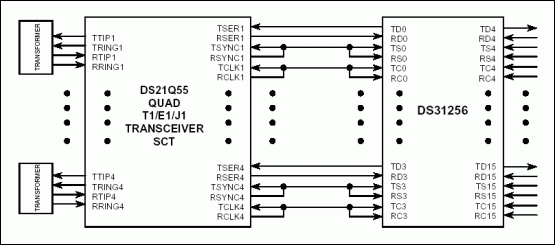
Figure 2. DS21Q55 connected to DS31256 in T1 mode.
Software Configuration
Tables 5 and 6 show some of the critical register settings necessary to initialize the DS31256 and DS21Q55 for operation as described above. Note that they might not represent the complete register listing required for a customer application. The reader is encouraged to refer to the device data sheet for further information regarding the flexibility of the DS31256 and DS21Q55.
| SETTING | LOCATION | FUNCTION |
| RSSO = 0 RSS1 = 0 RUEN = 0 |
RP[n]CR | Set Rx port T1 mode; Set Rx port channelized mode enable |
| TSSO = 0 TSS1 = 0 TUEN = 0 |
TP[n]CR | Set Tx port T1 mode; Set Tx port channelized mode enable |
| SETTING | LOCATION | FUNCTION |
| T1/E1 = 0 | MSTRREG.1 | Select the T1 operating mode |
| TSIO = 0 | TP[n]CR | Set Tx port T1 mode; Set Tx port channelized mode enable |
| RSIO = 0 | IOCR1.4 | RSYNC is an output |
| TCLKINV = 0 | IOCR2.6 | TCLK no inversion |
| RCLKINV = 0 | IUOCR2.7 | RCLK no inversion |
| RB8ZS = 1 | T1RCR2.5 | Receive B8ZS enabled |
| RFM = 1 | T1RCR2.6 | Receive ESF framing mode |
| TB8ZS = 1 | T1TCR2.7 | Transmit B8ZS enabled |
| TFM = 1 | T1CCR1.2 | Transmit ESF framing mode |
| RESE = 0 | ESCR.0 | Receieve elastic store is bypassed |
| TPD = 1 | LIC1.0 | Normal transmitter operation |
| TUA = 1 | LIC2.4 | Transmit data normally |
| ETS = 0 | LIC2.7 | T1 mode selected |
Connection in 8M Mode
Hardware Configuration
Figure 3 shows the connection between DS21Q55 and DS31256 in 8M mode. The four E1 data bus on the backplane bus is in frame interleave mode. The receive elastic store is enabled. The transmit clock is source from RCLK pin. The 8kHz transmit synchronization signal is generated from the RSYNC pin of the first device on the bus. All other devices on the bus have their frame syncs configured as inputs.
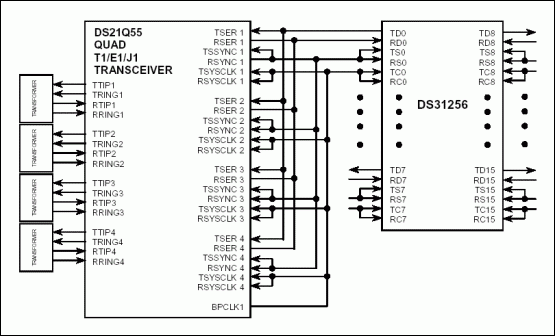
Figure 3. DS21Q50 connected to DS31256 in 8M mode.
Software Configuration
Tables 7 and 8 show some of the critical register settings necessary to initialize the DS31256 and DS2155 for operation as described above. Note that they might not represent the complete register listing required for a customer application. The reader is encouraged to refer to the device data sheet for further information regarding the flexibility of the DS31256 and DS2155.
| SETTING | LOCATION | FUNCTION |
| RSSO = 1 RSS1 = 1 RUEN = 0 |
RP[n]CR | Set Rx port 8.192MHz mode; Set Rx port channelized mode enable |
| TSSO = 1 TSS1 = 1 TUEN = 0 |
TP[n]CR | Set Tx port 8.192MHz mode; Set Tx port channelized mode enable |
| SETTING | LOCATION | FUNCTION |
| T1/E1 = 1 | MSTRREG.1 | Select the E1 operating mode |
| TCLKINV = 0 | IOCR2.6 | TCLK no inversion |
| RCLKINV = 0 | IUOCR2.7 | RCLK no inversion |
| SYNCE = 0 | E1RCR1.1 | Receive auto resync enabled |
| RHDB3 = 1 | E1RCR1.5 | Receive HDB3 enabled |
| RSIGM = 1 | E1RCR1.6 | Receive CCS signaling mode |
| RCRC4 = 1 | E1RCR1.3 | Receive CRC4 enabled |
| TCRC4 = 1 | E1TCR1.0 | Transmit CRC4 enabled |
| THDB3 = 1 | E1TCR1.2 | Transmit HDB3 enabled |
| RESE = 0 | ESCR.0 | Receieve elastic store is bypassed |
| TPD = 1 | LIC1.0 | Normal transmitter operation |
| TUA = 1 | LIC2.4 | Transmit data normally |
| ETS = 1 | LIC2.7 | E1 mode selected |
| RSCLKM = 1 | IOCR2_S1.0 | IBO enabled |
| TSCLKM = 1 | IOCR2_S1.1 | IBO enabled |
The following settings apply to the specified port (transceiver):
BPEN = 1 TC#1, CCR2.0 Enable BPCLK1 pin BPCS0 = 1 TC#1, CCR2.1 Backplane clock select BPCS1 = 0 TC#1, CCR2.2 8.192MHz
TSIO = 0 TC#1, IOCR1.1 TSYNC is an input RSIO = 0 TC#1, IOCR1.4 RSYNC is an output
TSIO = 0 TC#2, IOCR1.1 TSYNC2 is an input RSIO = 1 TC#2, IOCR1.4 RSYNC2 is an input
TSIO = 0 TC#3, IOCR1.1 TSYNC3 is an input RSIO = 1 TC#3, IOCR1.4 RSYNC3 is an input
TSIO = 0 TC#4, IOCR1.1 TSYNC4 is an input RSIO = 1 TC#4, IOCR1.4 RSYNC4 is an input
This is Transceiver #1 on the DA0 = 0 TC#1, IBOC.0 bus. DA1 = 0 TC#1, IBOC.1 DA2 = 0 TC#1, IBOC.2 IBOEN = 1 TC#1, IBOC.3 IBOSEL = 1 TC#1, IBOC.4 Interleave Bus Operation IBS0 = 1 TC#1, IBOC.5 enabled IBS1 = 0 TC#1, IBOC.6 Frame Interleave Operation Four transceivers on the bus
This is Transceiver #2 on the DA0 = 1 TC#1, IBOC.0 bus. DA1 = 0 TC#1, IBOC.1 DA2 = 0 TC#1, IBOC.2 IBOEN = 1 TC#1, IBOC.3 IBOSEL = 1 TC#1, IBOC.4 Interleave Bus Operation IBS0 = 1 TC#1, IBOC.5 enabled IBS1 = 0 TC#1, IBOC.6 Frame Interleave Operation Four transceivers on the bus
This is Transceiver #3 on the DA0 = 0 TC#1, IBOC.0 bus. DA1 = 1 TC#1, IBOC.1 DA2 = 0 TC#1, IBOC.2 IBOEN = 1 TC#1, IBOC.3 IBOSEL = 1 TC#1, IBOC.4 Interleave Bus Operation IBS0 = 1 TC#1, IBOC.5 enabled IBS1 = 0 TC#1, IBOC.6 Frame Interleave Operation Four transceivers on the bus
This is Transceiver #4 on the DA0 = 1 TC#1, IBOC.0 bus. DA1 = 1 TC#1, IBOC.1 DA2 = 0 TC#1, IBOC.2 IBOEN = 1 TC#1, IBOC.3 IBOSEL = 1 TC#1, IBOC.4 Interleave Bus Operation IBS0 = 1 TC#1, IBOC.5 enabled IBS1 = 0 TC#1, IBOC.6 Frame Interleave Operation Four transceivers on the bus
Where:
TC#1 = Transceiver #1 (TS1, TS0 = 00)
TC#2 = Transceiver #2 (TS1, TS0 = 01)
TC#3 = Transceiver #3 (TS1, TS0 = 10)
TC#4 = Transceiver #4 (TS1, TS0 = 11)
Connection with DS21Q50
Connection in 2M Mode
Hardware Configuration
Figure 4 shows the connection between the DS21Q50 and DS31256 in 2M mode. As the IBO function is disabled, the transmit clock of each port is source from TCLK pin, which is connected to SYSTLK1. The Layer 1 of DS31256 is configured as E1 port.
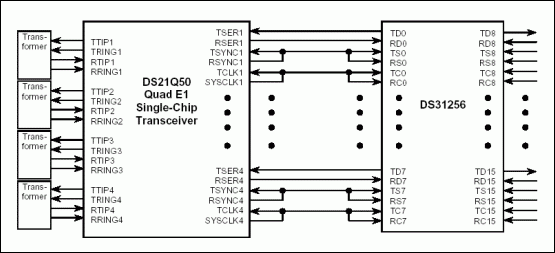
Figure 4. DS21Q50 connected to DS31256 in 2M mode.
Software Configuration
Tables 9 and 10 show some of the critical register settings necessary to initialize the DS31256 and DS21Q50 for operation as described above. Note that they might not represent the complete register listing required for a customer application. The reader is encouraged to refer to the device data sheet for further information regarding the flexibility of the DS31256 and DS21Q50.
| SETTING | LOCATION | FUNCTION |
| RSSO = 0 RSS1 = 1 RUEN = 0 |
RP[n]CR | Set Rx port E1 mode; Set Rx port channelized mode enable |
| TSSO = 0 TSS1 = 1 TUEN = 0 |
TP[n]CR | Set Tx port E1 mode; Set Tx port channelized mode enable |
| SETTING | LOCATION | FUNCTION |
| IBOEN = 0 | IBO.3 | Disable IBO operation |
| RSIO = 0 | RCR.5 | RSYNC pin is an output |
| RSM = 0 | RCR.6 | RSYNC is in frame mode |
| TSIO = 0 | TCR.0 | TSYNC in an input |
| TSM = 0 | TCR.1 | TSYNC is in frame mode |
Connection in 8M Mode
Hardware Configuration
Figure 5 shows the connection between the DS21Q50 and DS31256 in 8M mode. In order to ensure data integrity in IBO mode, all clock and sync signals should be phase-aligned. The receive-elastic store for each of the four transceivers must be enabled. They should all receive the same frame-reference pulse (RSYNC) and 8.192MHz system clock (SYSCLK). In this case, the phase-locked frame pulse is provided by the system backplane; and the 21Q50's system-clock synthesizer provides the 8.192MHz clock. Note that the 8.192MHz clock can be created internally from any of the four E1 line recovered clocks. In IBO mode, the DS21Q50 can create transmit clock (TCLK) for each E1 formatter by dividing down the applied SYSCLK. The Layer 1 of DS31256 is configured as channelized 8MHz port.
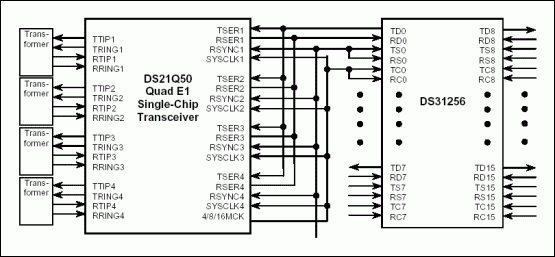
Figure 5. DS21Q50 connected to DS31256 in 8M mode.
Software Configuration
Tables 11 and 12 show some of the critical register settings necessary to initialize the DS31256 and DS21Q50 for operation as described above. Note that they might not represent the complete register listing required for a customer application. The reader is encouraged to refer to the device data sheet for further information regarding the flexibility of the DS31256 and DS21Q50.
| SETTING | LOCATION | FUNCTION |
| RSSO = 1 RSS1 = 1 RUEN = 0 |
RP[n]CR | Set Rx port 8.192MHz mode; Set Rx port channelized mode enable |
| TSSO = ` TSS1 = 1 TUEN = 0 |
TP[n]CR | Set Tx port 8.192MHz mode; Set Tx port channelized mode enable |
| RSM = 0 | RCR.6 | RSYNC is in frame mode |
| TSIO = 0 | TCR.0 | TSYNC in an input |
| TSM = 0 | TCR.1 | TSYNC is in frame mode |
| SETTING | LOCATION | FUNCTION |
| IBOEN = 1 | IBO.2 | Enable IBO operation |
| IBOTCS = 1 | IBO.6 | Transmit clock derived from SYSCLK |
| SCS0 = 0 | IBO.4 | 8.192MHz operation (4 ports on the PCM bus) |
| SCS1 = 1 | IBO.5 | |
| RESE = 1 | RCR.4 | Enable receive elastic store |
| RSIO = 1 | RCR.5 | RSYNC pin is an input |
| RSM = 0 | RCR.6 | RSYNC is in frame mode |
| TSIO = 1 | TCR.0 | TSYNC in an output |
| TSM = 0 | TCR.1 | TSYNC is in frame mode |
The following settings apply to the specified port (transceiver):
SCS0 = 1 TC#1, SCICR.0 Select the recovered clock from SCS1 = 0 TC#1, SCICR.1 transceiver #1 as the source for SCS2 = 0 TC#1, SCICR.2 the system clock synthesizer
CSS0 = 0 TC#1, SCICR.3 8.192MHz operation (4 ports on CSS1 = 1 TC#1, SCICR.4 the PCM bus)
SOE = 1 TC#1, SCICR.5 Enable synthesizer clock output
DA0 = 0 TC#1, IBO.0 Set transceiver #1 as the first DA1 = 0 TC#1, IBO.1 device on the PCM bus DA2 = 0 TC#1, IBO.2
DA0 = 1 TC#2, IBO.0 Set transceiver #2 as the second DA1 = 0 TC#2, IBO.1 device on the PCM bus DA2 = 0 TC#2, IBO.2
DA0 = 0 TC#3, IBO.0 Set transceiver #1 as the third DA1 = 1 TC#3, IBO.1 device on the PCM bus DA2 = 0 TC#3, IBO.2
DA0 = 1 TC#4, IBO.0 Set transceiver #4 as the fourth DA1 = 1 TC#4, IBO.1 device on the PCM bus DA2 = 0 TC#4, IBO.2
TSM = 0 TCR.1 TSYNC is in frame mode
Where:
TC#1 = Transceiver #1 (TS1, TS0 = 00)
TC#2 = Transceiver #2 (TS1, TS0 = 01)
TC#3 = Transceiver #3 (TS1, TS0 = 10)
TC#4 = Transceiver #4 (TS1, TS0 = 11)
Connection with DS26528
Connection in 8M Mode
Hardware Configuration
Figure 6 shows the connection between DS26528 and DS31256 in 8M mode. Two four E1 data bus (A and B) on the backplane bus is in frame interleave mode. The receive elastic store is enabled. The transmit clock is source from RCLK pin. The 8kHz transmit synchronization signal is generated from the RSYNC pin of the first device on the bus. All other devices on the bus have their frame syncs configured as inputs.

Figure 6. DS26528 connected to DS31256 in 8M mode.
Software Configuration
Tables 13 and 14 show some of the critical register settings necessary to initialize the DS31256 and DS26528 for operation as described above. Note that they might not represent the complete register listing required for a customer application. The reader is encouraged to refer to the device data sheet for further information regarding the flexibility of the DS31256 and DS26528.
| SETTING | LOCATION | FUNCTION |
| RSS0 = 1 RSS1 = 1 RUEN = 0 |
RP[n]CR | Set Rx port 8.192MHz mode; set Rx port channelized mode enable |
| TSS0 = 1 TSS1 = 1 TUEN = 0 |
TP[n]CR | Set Tx port 8.192MHz mode; set Tx port channelized mode enable |
| SETTING | LOCATION | FUNCTION |
| T1/E1 = 1 | TMMR.0 & RMMR.0 | Select the E1 operating mode |
| FRM_EN = 1 | TMMR.7 & RMMR.7 | Framer enabled |
| TCLKINV = 0 | TIOCR.7 | TCLK no inversion |
| RCLKINV = 0 | RIOCR.7 | RCLK no inversion |
| SYNCE = 0 | RCR1.2 | Receive auto resync enabled |
| RCRC4 = 1 | RCR1.3 | Receive CRC4 enabled |
| RSIGM = 1 | RCR1.5 | Receive CCS signaling mode |
| RHDB3 = 1 | RCR1.6 | Receive HDB3 enabled |
| TCRC4 = 1 | TCR1.0 | Transmit CRC4 enabled |
| THDB3 = 1 | TCR1.2 | Transmit HDB3 enabled |
| RESE = 0 | RESCR.0 | Receive elastic store is bypassed |
| T1J1E1S = 0 | LTRCR.1 | Configures the LIU for E1 operation |
| TE = 1 | LMCR.0 | TTIP/TRING outputs enabled |
| RSCLKM = 1 | RIOCR.4 | IBO enabled |
| TSCLKM = 1 | TIOCR.4 | IBO enabled |
| INIT_DONE = 1 | TMMR.6 & RMMR.6 | Set the INIT_DONE for each framer |
The following settings apply to the specified port (transceiver):
BPCLK0 = 0 GFCR.4 Enable BPCLK1 pin BPCLK1 = 1 GFCR.5 IBOMS0 = 0 GFCR.6 Backplane clock select IBOMS1 = 1 GFCR.7 8.192MHz
TSIO = 0 TC#1, TIOCR.2 TSYNC1 is an input RSIO = 0 TC#1, RIOCR.2 RSYNC1 is an output
TSIO = 0 TC#2,TIOCR.2 TSYNC2 is an input RSIO = 1 TC#2, RIOCR.2 RSYNC2 is an input
TSIO = 0 TC#3,TIOCR.2 TSYNC3 is an input RSIO = 1 TC#3, RIOCR.2 RSYNC3 is an input
TSIO = 0 TC#4,TIOCR.2 TSYNC4 is an input RSIO = 1 TC#4, RIOCR.2 RSYNC4 is an input
TSIO = 0 TC#5,TIOCR.2 TSYNC5 is an input RSIO = 0 TC#5, RIOCR.2 RSYNC5 is an output
TSIO = 0 TC#6,TIOCR.2 TSYNC6 is an input RSIO = 1 TC#6, RIOCR.2 RSYNC6 is an input
TSIO = 0 TC#7,TIOCR.2 TSYNC7 is an input RSIO = 1 TC#7, RIOCR.2 RSYNC7 is an input
TSIO = 0 TC#8, TIOCR.2 TSYNC8 is an input RSIO = 1 TC#8, RIOCR.2 RSYNC8 is an input
DA0 = 0 TC#1, RIBOC.0 This is Transceiver #1 on the DA1 = 0 TC#1, RIBOC.1 bus. DA2 = 0 TC#1, RIBOC.2 IBOEN = 1 TC#1, RIBOC.3 Interleave Bus Operation IBOSEL = 1 TC#1, RIBOC.4 enabled IBS0 = 1 TC#1, RIBOC.5 Frame Interleave Operation IBS1 = 0 TC#1, RIBOC.6 Four transceivers on the bus
DA0 = 1 TC#2, RIBOC.0 This is Transceiver #2 on the DA1 = 0 TC#2, RIBOC.1 bus. DA2 = 0 TC#2, RIBOC.2 IBOEN = 1 TC#2, RIBOC.3 TC#2, RIBOC.3 IBOSEL = 1 TC#2, RIBOC.4 enabled IBS0 = 1 TC#2, RIBOC.5 Frame Interleave Operation IBS1 = 0 TC#2, RIBOC.6 Four transceivers on the bus
DA0 = 0 TC#3, RIBOC.0 This is Transceiver #3 on the DA1 = 1 TC#3, RIBOC.1 bus. DA2 = 0 TC#3, RIBOC.2 IBOEN = 1 TC#3, RIBOC.3 Interleave Bus Operation IBOSEL = 1 TC#3, RIBOC.4 enabled IBS0 = 1 TC#3, RIBOC.5 Frame Interleave Operation IBS1 = 0 TC#3, RIBOC.6 Four transceivers on the bus
DA0 = 1 TC#4, RIBOC.0 This is Transceiver #4 on the DA1 = 1 TC#4, RIBOC.1 DA2 = 0 TC#4, RIBOC.2 IBOEN = 1 TC#4, RIBOC.3 Interleave Bus Operation IBOSEL = 1 TC#4, RIBOC.4 enabled IBS0 = 1 TC#4, RIBOC.5 Frame Interleave Operation IBS1 = 0 TC#4, RIBOC.6 Four transceivers on the bus
DA0 = 0 TC#5, RIBOC.0 This is Transceiver #5 on the DA1 = 0 TC#5, RIBOC.1 bus. DA2 = 0 TC#5, RIBOC.2 IBOEN = 1 TC#5, RIBOC.3 Interleave Bus Operation IBOSEL = 1 TC#5, RIBOC.4 enabled IBS0 = 1 TC#5, RIBOC.5 Frame Interleave Operation IBS1 = 0 TC#5, RIBOC.6 Four transceivers on the bus
DA0 = 1 TC#6, RIBOC.0 This is Transceiver #6 on the DA1 = 0 TC#6, RIBOC.1 bus. DA2 = 0 TC#6, RIBOC.2 Interleave Bus Operation IBOEN = 1 TC#6, RIBOC.3 enabled IBS0 = 1 TC#6, RIBOC.5 Frame Interleave Operation IBS1 = 0 TC#6, RIBOC.6 Four transceivers on the bus
DA0 = 0 TC#7, RIBOC.0 This is Transceiver #7 on the DA1 = 1 TC#7, RIBOC.1 bus. DA2 = 0 TC#7, RIBOC.2 IBOEN = 1 TC#7, RIBOC.3 Interleave Bus Operation IBOSEL = 1 TC#7, RIBOC.4 enabled IBS0 = 1 TC#7, RIBOC.5 Frame Interleave Operation IBS1 = 0 TC#7, RIBOC.6 Four transceivers on the bus
DA0 = 1 TC#8, RIBOC.0 This is Transceiver #8 on the DA1 = 1 TC#8, RIBOC.1 DA2 = 0 TC#8, RIBOC.2 BOEN = 1 TC#8, RIBOC.3 Interleave Bus Operation IBOSEL = 1 TC#8, RIBOC.4 enabled IBS0 = 1 TC#8, RIBOC.5 Frame Interleave Operation IBS1 = 0 TC#8, RIBOC.6 Four transceivers on the bus Note: The address of TC#1 to TC#8 is 1001H + (20h x n): where n = 0 to 7, for ports 1 to 8
Conclusion
This application note describes how to connect the DS31256 HDLC controller to the DS2155, DS21Q55, DS26528, and DS21Q50 in T1/E1, 2MHz, 4MHz, and 8MHz mode. The hardware and software configuration are given. Users are encouraged to contact the factory for support of their particular application.
If you have further questions about our HDLC controller products, please contact the Telecommunication Applications support team
{{modalTitle}}
{{modalDescription}}
{{dropdownTitle}}
- {{defaultSelectedText}} {{#each projectNames}}
- {{name}} {{/each}} {{#if newProjectText}}
-
{{newProjectText}}
{{/if}}
{{newProjectTitle}}
{{projectNameErrorText}}
